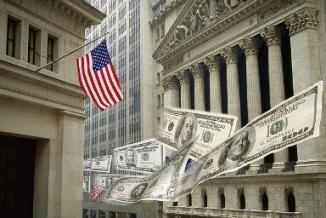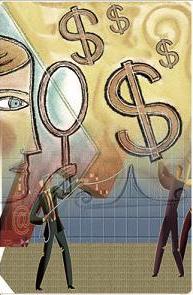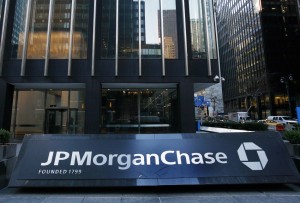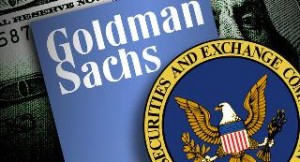The Speculative Endgame: The Government “Shutdown” and “Debt Default”, A Multibillion Bonanza for Wall Street

A wave of speculative activity is sweeping major markets.
The uncertainty regarding the shutdown and “debt default” constitutes a golden opportunity for “institutional speculators”. Those who have reliable “inside information” regarding the complex outcome of the legislative process are slated to make billions of dollars in windfall gains.
Speculative Bonanza
Several overlapping political and economic agendas are unfolding. In a previous article, we examined the debt default saga in relation to the eventual privatization of important components of the federal State system.
 While Wall Street exerts
a decisive influence on policy and legislation pertaining to the
government shutdown, these same major financial institutions also
control the movement of currency markets, commodity and stock markets
through large scale operations in derivative trade.
While Wall Street exerts
a decisive influence on policy and legislation pertaining to the
government shutdown, these same major financial institutions also
control the movement of currency markets, commodity and stock markets
through large scale operations in derivative trade.Most of the key actors in the US Congress and the Senate involved in the shutdown debate are controlled by powerful corporate lobby groups acting directly or indirectly on behalf of Wall Street. Major interests on Wall Street are not only in a position to influence the results of the Congressional process, they also have “inside information” or prior knowledge of the chronology and outcome of the government shutdown impasse.
They are slated to make billions of dollars in windfall profits in speculative activities which are “secure” assuming that they are in a position to exert their influence on relevant policy outcomes.
It should be noted, however, that there are important divisions both within the US Congress as well as within the financial establishment. The latter are marked by the confrontation and rivalry of major banking conglomerates.
These divisions will have an impact on speculative movements and counter movements in the stock, money and commodity markets. What we are dealing with is “financial warfare”. The latter is by no means limited to Wall Street, Chinese, Russian and Japanese financial institutions (among others) will also be involved in the speculative endgame.
Speculative movements based on inside information, therefore, could potentially go in different directions. What market outcomes are being sought by rival banking institutions? Having inside information on the actions of major banking competitors is an important element in the waging of major speculative operations.
Derivative Trade
 The
major instrument of “secure” speculative activity for these financial
actors is derivative trade, with carefully formulated bets in the stock
markets, major commodities –including gold and oil– as well as foreign
exchange markets.
The
major instrument of “secure” speculative activity for these financial
actors is derivative trade, with carefully formulated bets in the stock
markets, major commodities –including gold and oil– as well as foreign
exchange markets.These major actors may know “where the market is going” because they are in a position to influence policies and legislation in the US Congress as well as manipulate market outcomes.
Moreover, Wall Street speculators also influence the broader public’s perception in the media, not to mention the actions of financial brokers of competing or lesser financial institutions which do not have foreknowledge or access to inside information.
These same financial actors are involved in the spread of “financial disinformation”, which often takes the form of media reports which contribute to either misleading the public or building a “consensus” among economists and financial analysts which will push markets in a particular direction.
Pointing to an inevitable decline of the US dollar, the media serves the interests of the institutional speculators in camouflaging what might happen in an environment characterized by financial manipulation and the interplay of speculative activity on a large scale.
Speculative trade routinely involves acts of deception. In recent weeks, the media has been flooded with “predictions” of various catastrophic economic events focusing on the collapse of the dollar, the development of a new reserve currency by the BRICS countries, etc.
At a recent conference hosted by the powerful Institute of International Finance (IIF), a Washington based think tank organization which represents the world’s most powerful banks and financial institutions:
“Three of the world’s most powerful bankers warned of terrible consequences if the United States defaults on its debt, with Deutsche Bank chief executive Anshu Jain claiming default would be “utterly catastrophic.”
This would be a very rapidly spreading, fatal disease, … I have no recommendations for this audience…about putting band aids on a gaping wound,” he said.
“JPMorgan Chase chief executive Jamie Dimon and Baudouin Prot, chairman of BNP Paribas, said
a default would have dramatic consequences on the value of U.S. debt
and the dollar, and likely would plunge the world into another
recession.” (…)
Dimon and other top executives from major U.S. financial firms met with President Barack Obama and with lawmakers last week to urge them to deal with both issues.
On Saturday, Dimon said banks are already spending “huge amounts” of money preparing for the possibility of a default, which he said would threaten the global recovery after the 2007-2009 financial crisis.
Dimon also defended JPMorgan against
critics who say the bank has become too big to manage. It has come under
scrutiny from numerous regulators and on Friday reported its first
quarterly loss since Dimon took over, due to more than $7 billion in
legal expenses. (Emily Stephenson and Douwe Miedema, World top bankers warn of dire consequences if U.S. defaults | Reuters, October 12, 2013
What these “authoritative” economic assessments are intended to
create is an aura of panic and economic uncertainty, pointing to the
possibility of a collapse of the US dollar.What is portrayed by the Institute of International Finance panelists (who are the leaders of the world’s largest banking conglomerates) is tantamount to an Economics 101 analysis of market adjustment, which casually excludes the known fact that markets are manipulated with the use of sophisticated derivative trading instruments. In a bitter irony, the IIF panelists are themselves involved in routinely twisting market values through derivative trade. Capitalism in the 21st century is no longer based largely on profits resulting from a real economy productive process, windfall financial gains are acquired through large scale speculative operations, without the occurrence of real economy activity. at the touch of a mouse button.
 The
manipulation of markets is carried out on the orders of major bank
executives including the CEOs of JPMorgan Chase, Deutsche Bank and BNP
Paribas.
The
manipulation of markets is carried out on the orders of major bank
executives including the CEOs of JPMorgan Chase, Deutsche Bank and BNP
Paribas.The “too big to fail banks” are portrayed, in the words of JPMorgan Chase’s CEO Jamie Dimon’s, as the “victims” of the debt default crisis, when in fact they are the architects of economic chaos as well as the unspoken recipients of billions of dollars of stolen taxpayers’ money.
These corrupt mega banks are responsible for creating the “gaping wound” referred to by Deutsche Bank’s Anshu Jain in relaiton to the US public debt crisis.
Collapse of the Dollar?
Upward and downward movements of the US dollar in recent years have little do with normal market forces as claimed by the tenets of neoclassical economics.
Both JP Morgan Chase’s CEO Jamie Dimon and Deutsche Bank’s CEO Anshu Jain’s assertions provide a distorted understanding of the functioning of the US dollar market. The speculators want to convince us that the dollar will collapse as part of a normal market mechanism, without acknowledging that the “too big to fail” banks have the ability to trigger a decline in the US dollar which in a sense obviates the functioning of the normal market.
Wall Street has indeed the ability to “short” the greenback with a view to depressing its value. It has also has the ability through derivative trade of pushing the US dollar up. These up and down movements of the greenback are, so to speak, the “cannon feed” of financial warfare. Push the US dollar up and speculate on the upturn, push it down and speculate on the downturn.
It is impossible to assess the future movement of the US dollar by solely focusing on the interplay of “normal market” forces in response to the US public debt crisis.
While an assessment based on “normal market” forces indelibly points to structural weaknesses in the US dollar as a reserve currency, it does not follow that a weakened US dollar will necessarily decline in a forex market which is routinely subject to speculative manipulation.
Moreover, it is worth noting that the national currencies of several heavily indebted developing countries have increased in value in relation to the US dollar, largely as a result of the manipulation of the foreign exchange markets. Why would the national currencies of countries literally crippled by foreign debt go up against the US dollar?
The Institutional Speculator
 JPMorgan
Chase, Goldman Sachs, Bank America, Citi-Group, Deutsche Bank et al:
the strategy of the institutional speculators is to sit on their
“inside information” and create uncertainty through heavily biased news
reports, which are in turn used by individual stock brokers to advise
their individual clients on “secure investments”. And that is how people
across America have lost their savings.
JPMorgan
Chase, Goldman Sachs, Bank America, Citi-Group, Deutsche Bank et al:
the strategy of the institutional speculators is to sit on their
“inside information” and create uncertainty through heavily biased news
reports, which are in turn used by individual stock brokers to advise
their individual clients on “secure investments”. And that is how people
across America have lost their savings.It should be emphasized that these major financial actors not only control the media, they also control the debt rating agencies such as Moody’s and Standard and Poor.
According to the mainstay of neoclassical economics, speculative trade reflects the “normal” movement of markets. An absurd proposition.
Since the de facto repeal of the Glass-Steagall Act and the adoption of the Financial Services Modernization Act in 1999, market manipulation tends to completely overshadow the “laws of the market”, leading to a highly unstable multi-trillion dollar derivative debt, which inevitably has a bearing on the current impasse on Capitol Hill. This understanding is now acknowledged by sectors of mainstream financial analysis.
There is no such thing as “normal market movements”. The outcome of the government shutdown on financial markets cannot be narrowly predicted by applying conventional macro-economic analysis, which excludes outright the role of market manipulation and derivative trade.
The outcome of the government shutdown on major markets does not hinge upon “normal market forces” and their impacts on prices, interest rates and exchange rates. What has to be addressed is the complex interplay of “normal market forces” with a gamut of sophisticated instruments of market manipulation. The latter consist of an interplay of large scale speculative operations undertaken by the most powerful and corrupt financial institutions, with the intent to distorting “normal” market forces.
It is worth mentioning that immediately following the adoption of the Financial Services Modernization Act in 1999, the US Congress adopted the Commodity Futures Modernization Act 2000 (CFMA) which essentially “exempted commodity futures trading from regulatory oversight.”
 Four
major Wall Street financial institutions account for more than 90
percent of the so-called derivative exposure: J.P. Morgan Chase,
Citi-Group, Bank America, and Goldman Sachs. These major banks exert a
pervasive influence on the conduct of monetary policy, including the
debate within the US Congress on the debt ceiling. They are also among
the World’s largest speculators.
Four
major Wall Street financial institutions account for more than 90
percent of the so-called derivative exposure: J.P. Morgan Chase,
Citi-Group, Bank America, and Goldman Sachs. These major banks exert a
pervasive influence on the conduct of monetary policy, including the
debate within the US Congress on the debt ceiling. They are also among
the World’s largest speculators.What is the speculative endgame behind the shutdown and debt default saga?
An aura of uncertainty prevails. People across America are impoverished as a result of the curtailment of “entitlements”, mass protest and civil unrest could erupt. Homeland Security (DHS) is the process of militarizing domestic law enforcement. In a bitter irony, each and all of these economic and social events including political statements and decisions in the US Congress concerning the debt ceiling, the evaluations of the rating agencies, etc. create opportunities for the speculator.
Major speculative operations –feeding on inside information and deception– are likely take place routinely over the next few months as the fiscal and debt default crisis unfolds.
What is diabolical in this process is that major banking conglomerates will not hesitate to destabilize stock, commodity and foreign exchange markets if it serves their interests, namely as a means to appropriate speculative gains resulting from a situation of turmoil and economic crisis, with no concern for the social plight of millions of Americans.
 One
solution –which is unlikely to be adopted unless there is a major power
shift in American politics– would be to cancel the derivative debt
altogether and freeze all derivative transactions on major markets. This
would certainly help to tame the speculative onslaught.
One
solution –which is unlikely to be adopted unless there is a major power
shift in American politics– would be to cancel the derivative debt
altogether and freeze all derivative transactions on major markets. This
would certainly help to tame the speculative onslaught.The manipulation through derivative trade of the markets for basic food staples is particularly pernicious because it potentially creates hunger. It has a direct bearing on the livelihood of millions of people.
As we recall, “the price of food and other commodities began rising precipitately [in 2006], … Millions were cast below the poverty line and food riots erupted across the developing world, from Haiti to Mozambique.”
According to Indian economist Dr. Jayati Ghosh:
“It is now quite widely acknowledged that
financial speculation was the major factor behind the sharp price rise
of many primary commodities , including agricultural items over the past
year [2011]… Even recent research from the World Bank (Bafis and
Haniotis 2010) recognizes the role played by the “financialisation of
commodities” in the price surges and declines, and notes that price
variability has overwhelmed price trends for important commodities.”
(Quoted in Speculation in Agricultural Commodities: Driving up the Price of Food Worldwide and plunging Millions into Hunger By , October 05, 2011)
The artificial hikes in the price of crude oil, which are also the
result of market manipulation, have a pervasive impact on costs of
production and transportation Worldwide, which in turn contribute to
spearheading thousands of small and medium sized enterprises into
bankruptcy.Big Oil including BP as well Goldman Sachs exert a pervasive impact on the oil and energy markets.
The global economic crisis is a carefully engineered.
The end result of financial warfare is the appropriation of money wealth through speculative trade including the confiscation of savings, the outright appropriation of real economy assets as well as the destabilization of the institutions of the Federal State through the adoption of sweeping austerity measures.
The speculative onslaught led by Wall Street is not only impoverishing the American people, the entire World population is affected.



No comments:
Post a Comment